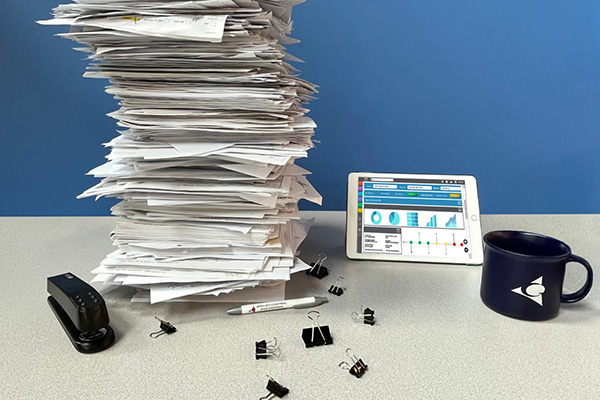Ditch the paperwork and discover how a paper-on-glass strategy can boost compliance, agility, and performance on the plant floor.
by Joe Rappazzo, Director of Operations, Applied Control Engineering
As manufacturers modernize operations, a critical foundational step must involve implementing a “paper-on-glass” strategy. Key to digital transformation efforts, this approach replaces traditional paper-based documentation such as work instructions, production logs, standard operating procedures (SOPs), checklists, and quality forms, with dynamic, screen-based interfaces accessible at the point of use. Whether displayed on tablets, industrial HMIs, or kiosks, these digital documents provide the tools needed to work more accurately and efficiently and help keep production in compliance with regulatory standards.
For business leaders focused on productivity, quality, and sustainability, implementing a paper-on-glass strategy is essential; yet, for many companies, the shift away from legacy paper-based systems remains a daunting step. This article explores the many tangible business benefits of developing a paper-on-glass strategy and tips on how to get started in your organization.
Digitizing traditional paper documentation doesn’t just streamline the operator experience; it enhances visibility across the entire plant floor and provides a digital backbone for a variety of activities. Below are some of the key benefits you can expect to experience when implementing a paper-on-glass strategy for required documentation in your operations.
Paper-on-glass ensures operators are always working from the latest standard operating procedures (SOPs) and using up-to-date production forms. When needed, updates can be rolled out to these digital documents in seconds, reducing the lag time and risk that often comes with implementing revisions to paper documents.
Another benefit for operators is that digital forms can be interactive, prompting users to validate entries and providing embedded links to help content for common issues. Digital forms can also be designed to include intuitive visual workflows so that operators don’t have to memorize procedures and can instead follow on-screen prompts, reducing training time and eliminating variability in execution.

In fast-paced manufacturing environments, agility is key. When new products or processes are introduced, companies must act quickly to update work instructions and ensure adoption. Digital SOPs make this possible by allowing rapid deployment of revisions and immediate feedback from frontline teams.
The process of digitizing SOPs also helps formalize procedures that might otherwise exist only in the minds of tenured operators. Preserving critical institutional knowledge and creating a consistent training foundation for the next generation is essential as more experienced personnel retire.
In traditional paper-based systems, valuable operational data often goes underutilized as documents are stored in filing cabinets, scanned into inaccessible PDFs, or left waiting for someone to manually enter data into a spreadsheet (a process that is often riddled with errors). But when data entry is part of your paper-on-glass glass strategy, this process becomes structured, reducing errors and making data immediately searchable and ready for analysis.
This digital data enables richer analytics through business intelligence tools and facilitates the quick production of performance dashboards, quality reports, and trend identification. Because data is logged in real time, managers can make faster, more informed decisions and spot issues before they escalate.
In heavily regulated industries like pharmaceuticals and food and beverage, the cost of non-compliance is steep. Paper-on-glass simplifies the task of meeting regulatory standards by providing traceable, revision-controlled digital records. For example, electronic batch records include a full history of who completed a batch, each action they took, and when it was completed. Even if some information still requires manual entry, paper-on-glass creates a clear pathway to fully digital documentation systems, reducing the risk of human error and making regulatory reporting more straightforward.
Reducing paper waste might seem like a modest benefit, but for high-volume manufacturing operations, the environmental and cost impact is significant. Transitioning to digital forms not only decreases the need for printing and storage, but it also aligns directly with the corporate sustainability goals for many organizations.
In many facilities, shift turnover is still reliant on paper logs, which comes with challenges such as inconsistent detail and illegible handwriting. With paper-on-glass, handoff forms are standardized, digital, and accessible from any connected device. Operators can also communicate more effectively with the incoming team and provide more details on any issues or anomalies noticed, improving continuity and uptime.
Digitized shift reports can even feed into morning dashboards that summarize the prior day’s production, maintenance activity, and alarms. When combined with other system data, these insights can help teams respond faster and operate more proactively.
Because digital systems log every action taken and by whom, manufacturers can more easily conduct a root cause analysis when something goes wrong. When paired with process historian data, these digital records offer a more complete picture of what happened and why, enabling troubleshooting and continuous improvement efforts based on real data rather than assumptions.
Successful implementation of a paper-on-glass strategy requires a thoughtful, strategic rollout. Below are a few high-level considerations for leadership teams to think about when making the transition.
A good place to start is to look for processes with repetitive tasks, manual data entry, or high compliance risk such as batch records, shift handoff forms, or paper-based quality checks. These are usually small enough to pilot, but impactful enough to demonstrate value. Measuring outcomes from these pilot implementations, such as reduced training time or quality review time, can provide data to build support for a broader rollout. Demonstrating quick wins can help secure buy-in from both technical and financial stakeholders.
When moving from paper to digital documents, change management is often a big hurdle. To minimize adoption challenges, involve operators, technicians, supervisors, maintenance personnel, and anyone else who frequently interacts with your systems early. When frontline users are bought in at the onset of these projects, you can ensure new documentation processes meet their needs, which will facilitate adoption.
If operators are used to carrying clipboards to view production instructions or record data, you’ll want your paper-on-glass strategy to include the use of tablets. This will involve working with your OT/IT teams to ensure proper Wi-Fi connectivity and network access and that the required IT procedures and policies are in place. And, wherever possible, enable auto gathering of data by making connections with existing systems such as your manufacturing execution systems (MES) or enterprise resource planning (ERP) platform that already supports digital forms and data collection.
A paper-on-glass strategy isn’t just about eliminating paperwork. It’s about enabling a smarter, faster, and more connected manufacturing environment. By digitizing essential documentation and workflows, manufacturers can drive measurable improvements in efficiency, accuracy, and compliance while reducing environmental impact.
For business leaders, this approach offers a scalable path to digital transformation that strengthens workforce productivity, captures institutional knowledge, and positions the organization to respond quickly to change. Whether you start with shift handoff forms or SOPs, each digital step forward lays the groundwork for more agile, data-driven operations.

About the Author:
Joe Rappazzo started at Applied Control Engineering (ACE) in 2014 as a control system engineer after earning a Bachelor of Science in Mechanical Engineering from Drexel University. Joe quickly became a key technical lead with expertise in batch control systems for the life sciences industry. In 2017, Joe joined the manufacturing execution systems (MES) leadership team where he helped drive a remarkable 20x growth in MES business, making it one of ACE’s key successes in the last decade. After being promoted to team leader in 2021, Joe cultivated a culture of collaboration and operational excellence in the Delaware office. In October 2024, he advanced to the Director of Operations role, where he continues to lead growth, drive efficiency, and mentor teams to deliver exceptional results.
Read more from the author:
How to Read & Write Rockwell PLC Tag Values with Excel | Applied Control Engineering, February 2024
A Pharmaceutical Customer Gains Benefits from a Long-Term Relationship with ACE | Applied Control Engineering, March 2022
In this episode, I sat down with Beejan Giga, Director | Partner and Caleb Emerson, Senior Results Manager at Carpedia International. We discussed the insights behind their recent Industry Today article, “Thinking Three Moves Ahead” and together we explored how manufacturers can plan more strategically, align with their suppliers, and build the operational discipline needed to support intentional, sustainable growth. It was a conversation packed with practical perspectives on navigating a fast-changing industry landscape.